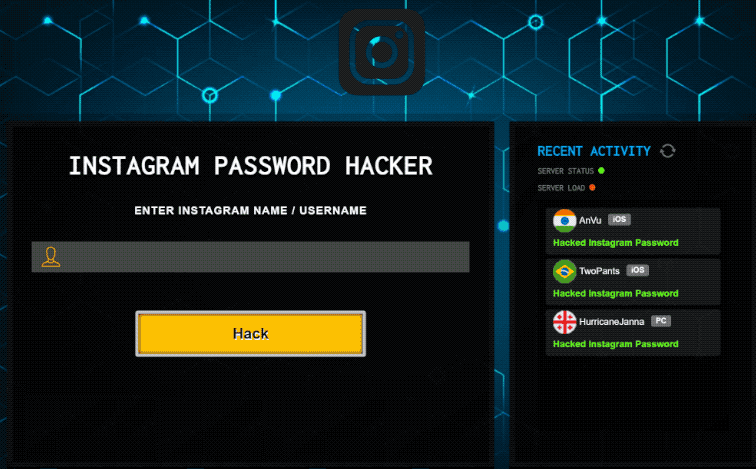“Instagram Password Hacker” scam refers to a fake tool that claims to allow users to get Instagram account passwords after typing in the Instagram username. This particular scam operates as part of a phishing campaign that tries to trick users into revealing their personal information.
“Instagram Password Hacker” is one of many fake tools that promise to give users access to someone else’s Instagram account. When users enter the site, they will be greeted with a message saying “Instagram Password Hacker” and instructions saying users need to enter the Instagram name/username in the field below to get the password for the account.
The site has a “Recent Activity” field on the right side, and it displays supposedly successful hacking attempts. If users scroll down, they will see fake comments from users who supposedly successfully used the tool and gained unauthorized access to someone’s Instagram account.
If users type in anything in the field and press “Hack”, they will get a message saying that the password has been successfully hacked. A download button then appears. If users click on it, they will be taken to another site that asks them to verify that they are human. To do that, users are asked to send an SMS, after which they will be given the password to download.
If users send the SMS as instructed, they will be giving away their phone numbers to malicious actors. Users may also receive a message back, with a file attached to it, supposedly the password. While getting users’ phone numbers is likely the scam’s main goal, scammers may also try to spread malware by concealing it as password files and sending it to users who send the initial SMS.
If users open the attached file, they may end up infecting their device with something malicious. The file will certainly not contain any passwords. Users could end up with keylogger, trojan, crypto miners, and ransomware infections. Depending on the malicious infection, users’ sensitive data may be stolen. A keylogger infection would steal users’ passwords and possibly even banking information, while ransomware may lock the whole device until a payment is made. To avoid malware infections, users should never open any file attachments or click on links sent by unknown senders.
If you were thinking of using the supposed Instagram hacker to gain access to someone’s Instagram account, know that unauthorized access to any account is illegal. You should also know that these online tools that claim to find passwords for social media platforms are always fake. Gaining access to someone’s social media account is very difficult and certainly is not as simple as typing in a username and pressing “Hack” on some online website.
How do users end up on sites hosting the “Instagram Password Hacker” scam?
In this particular case, users who end up on the site hosting the “Instagram Password Hacker” scam were likely looking for it with the intention of gaining unauthorized access to someone’s Instagram account. Links to the site can appear in search engines when users type in “Instagram password hack” and similar inquiries.
It’s also possible to be redirected to it while browsing high-risk websites or by an adware infection. Certain websites (e.g. sites with pornographic or pirated content) are known to trigger redirects no matter what users click on. A good adblocker program is usually enough to prevent these pop-ups and redirects.
If redirects are happening regularly, users’ computers may be infected with adware. It’s a minor but frustrating infection that bombards users with advertisement content, including ads and redirects. Adware is usually installed via the software bundling method. The way it works is infections like adware and browser hijackers are added to free programs as extra offers and permitted to install alongside without requiring explicit permission. The offers are technically optional but they need to be manually deselected to prevent them from installing. The offers are also hidden in settings users don’t normally use, which prevents many users from deselecting them.
When installing programs, it’s important to use Advanced (Custom) settings. The installation window recommends using Default but doing that will allow all added offers to be installed. However, Advanced settings will make all offers visible, and give you the option to deselect all offers. It’s always recommended to deselect all offers because legitimate programs do not use this installation method. Programs that do are often detected as potential threats by anti-virus programs.
Most free programs will come with added offers. Unless you want to fill your computer with junk programs, always deselect all offers.
How to remove “Instagram Password Hacker” scam
If you have used this service and opened the file sent to you, we strongly recommend checking your device for a malware infection. There’s not much you can do if you have given scammers your phone number but you can at least be on guard for unsolicited phone calls.
Site Disclaimer
2-remove-virus.com is not sponsored, owned, affiliated, or linked to malware developers or distributors that are referenced in this article. The article does not promote or endorse any type of malware. We aim at providing useful information that will help computer users to detect and eliminate the unwanted malicious programs from their computers. This can be done manually by following the instructions presented in the article or automatically by implementing the suggested anti-malware tools.
The article is only meant to be used for educational purposes. If you follow the instructions given in the article, you agree to be contracted by the disclaimer. We do not guarantee that the artcile will present you with a solution that removes the malign threats completely. Malware changes constantly, which is why, in some cases, it may be difficult to clean the computer fully by using only the manual removal instructions.
